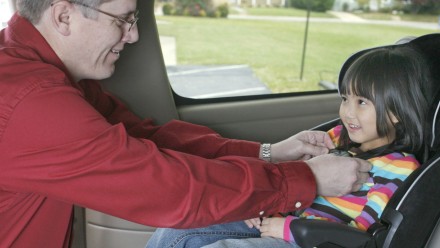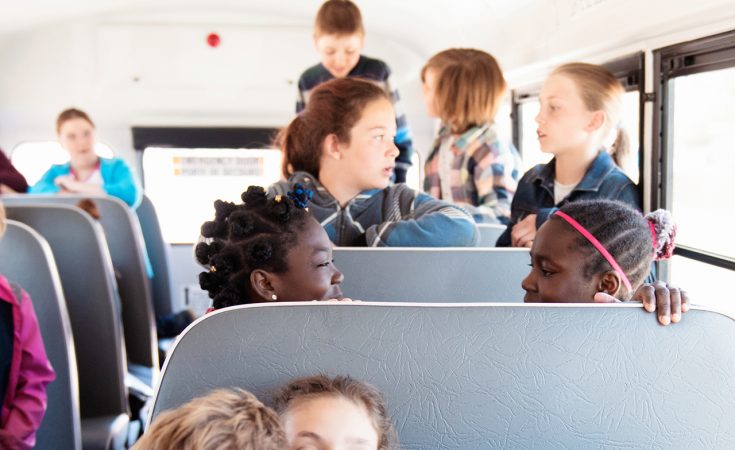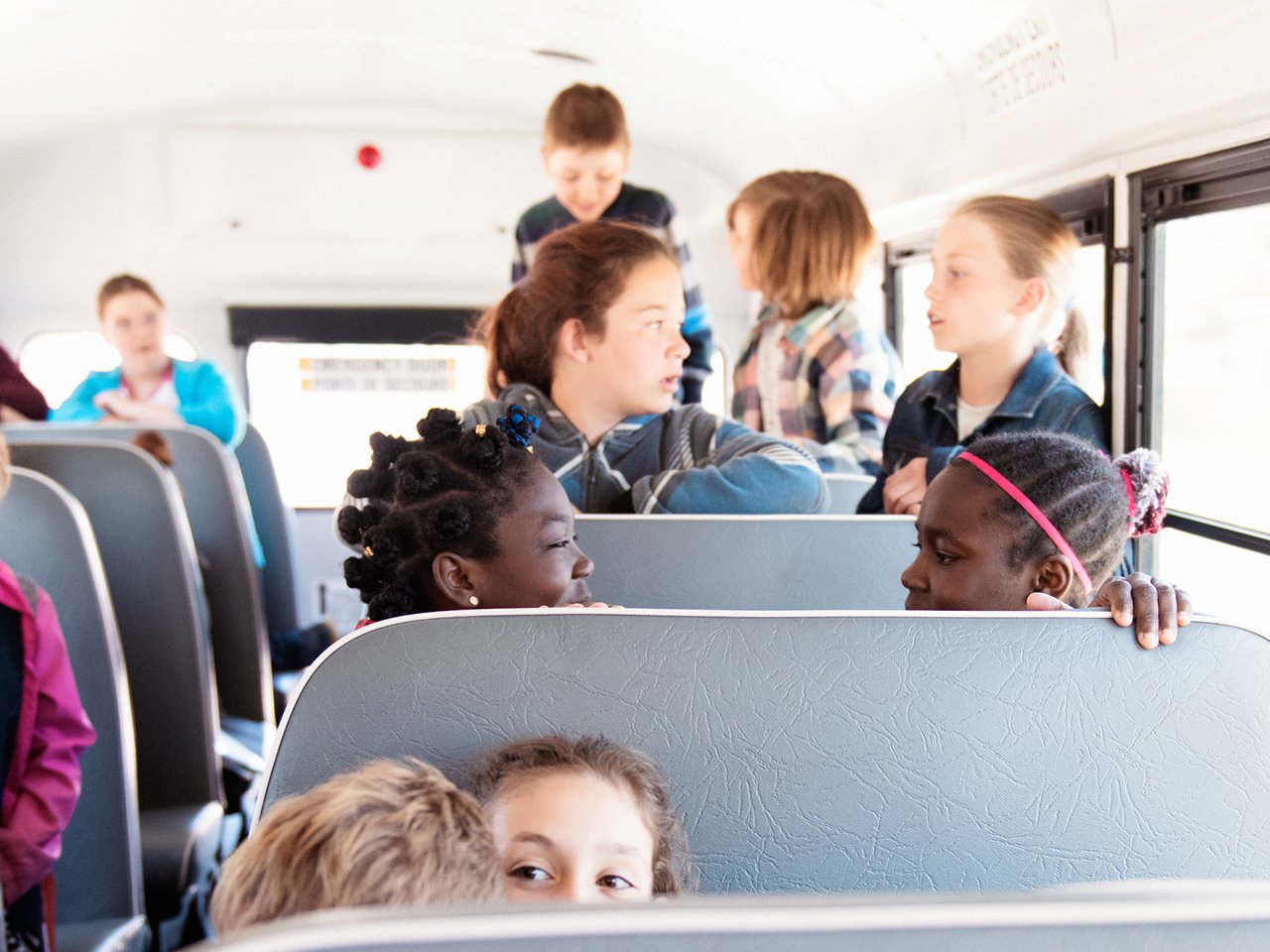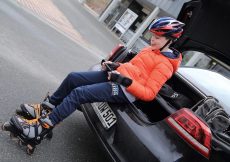When you send your kid off to school on a bus this year you can take comfort in the fact that school buses are considered some of the safest vehicles on the road—they are large, high, heavy and bright yellow, making them easily visible. They also have flashing lights and other safety features like a stop sign and a stop arm that make them less likely than cars or pedestrians to be involved in accidents.
According to the National Collision Database, between 2009 and 2018 there was only one fatality related to travelling to and from school on a bus, and Transport Canada says students are about 80 times more likely to get to school safely in a school bus than in a car. But would school buses be even safer with seat belts?
It’s a question on the mind of our government leaders, as well. In June, after months of discussion, the House of Commons transportation committee opted not to call for seat belts on school buses, saying that further studies are needed. A task force, made up of government representatives, school bus operators, school districts, manufacturers, safety organizations and labour unions, continues to look at the issue.
The story is a bit different in the United States, where buses in eight states now have seat belts, and organizations including the American Academy of Pediatrics, the National Safety Council and the National Transportation Safety Board recommend school buses be outfitted with seat belts. But the issue in Canada is not as clear cut.
Different crashes, different issues
Transport Canada and other organizations point to something called “compartmentalization” as a feature that makes school buses safe without seat belts. The idea is that the high, padded seats, placed close together, will absorb much of the energy of a collision and help protect passengers in a front or rear impact, the most common type of school bus collisions. Other studies, including an unreleased 2010 Transport Canada study that was the subject of a CBC The Fifth Estate investigative report in fall 2018, say that compartmentalization is not effective in other types of crashes.
“[Compartmentalization] is not going to work if you are in a side impact, it’s not going to work if you are in a rollover,” says Kathleen Klinich, an associate research scientist at the University of Michigan Transportation Research Institute, who studies how to protect child passengers in crashes. “You can have kids falling out of their seats and getting injured. If you’re in a rollover, everybody is going to be piled up on one side of the bus on top of each other.”
Gary Lillico, a school bus driver in Harrison Hot Springs, BC, who saw the Fifth Estate episode and then started an online petition (106,000 signatures and counting) and Facebook group lobbying for seat belts on school buses, also has concerns about the real-world application of compartmentalization. “Kids are never sitting perfectly the way the compartmentalization seats are designed for. There are feet in the aisles and kids switching seats when you’re not looking,” he says.
The problem with seat belts
Keeping kids restrained with seat belts doesn’t automatically makes things safer, though. According to the Canada Safety Council (CSC) injuries can result because of seat belts. For example, the organization says on its website that lap belts could increase the risk of head and neck injuries in a collision, with the head striking the seat at greater force than if the whole body hit the seat. Similarly, it says shoulder belts could lead to abdominal injuries if the kid has slipped down in the seat. Another concern: how easily kids would be able to release the belts in an emergency evacuation. However, the Canada Safety Council wouldn’t allow a spokesperson to speak with us for this story, noting, “The issue of seat belts on school buses is currently being reviewed by Transport Canada in conjunction with several industry stakeholders. Because of this, CSC has not been commenting on the issue and will await the findings of the review before having anything to add to the conversation.”

For its part, Transport Canada notes that seat belts used the wrong way can have “a negative impact on safety,” but also that “When they are used and installed properly, seat belts on school buses can offer another layer of safety to complement the existing, highly effective protection provided by compartmentalization.”
Lilico and Klinich both point to manufacturers that specialize in seat belts for school buses. They make belt systems that can be installed in new buses or retrofitted in most existing buses, and can be configured to safely fit small children and big teenagers, as well as fit three to a seat, which can be common in elementary school buses.
The logistics of belts on buses
It’s having those belts used correctly that’s of concern to Vicky Kyriaco, general manager and Chief Administrative Officer of Ottawa Student Transportation Authority, and part of the interprovincial task force. She testified before the House of Commons transportation committee and spoke about her concerns about the ability of little kids to buckle up without assistance. “We would be expecting four-year-olds and five-year-olds who, are encumbered with backpacks and who can barely get up the bus stairs, to somehow manage getting the backpack in the seat, getting into their seat, attaching the seat belt on their own and then applying the seat belt so that it’s nice and tight, which is key,” she says. She also thinks we need crash studies about the effect of bulky snowsuits on emergency evacuation and wonders how the smaller kids will handle taking mitts on and off to buckle up. “Let’s have some new studies and let’s have them reflect conditions in Canada,’” she says.
There’s also the aspect of liability: “At this point, unless the law changes at a provincial level, it would be the bus driver’s responsibility to ensure that all the kids are clicked in properly all the time,” says Kyriaco —a responsibility that drivers would understandably be reluctant to take on, given the demerit points and possible loss of license associated with tickets for unbuckled passengers.
Adding a bus monitor on each bus would help mitigate that responsibility, but she says that some areas already have a driver shortage and finding enough part-time monitors would also be tricky. Lillico recognizes his fellow drivers’ concerns but notes how California, which has seat belts on school buses, handled the dilemma. “On departure, the driver must walk the school bus from front to back and back to front and check all the kids are properly belted in. Conversely in the morning, during pick up, he has to tell the kids, ‘Good morning, don’t forget to buckle up.’”
Who’s going to pay for it?
Replacing or retrofitting thousands of school buses adds up quickly. “Safety shouldn’t come at a cost, but it does, and that cost has to be mitigated somehow,” says Kyriaco. “It usually ends up that fewer kids would get transportation… And so the irony is that those kids, who can no longer go on school buses because we can’t deliver the same service, are in their cars, and cars are less safe than a yellow school bus.”
Currently, it’s up to individual provinces, school boards and the companies that operate school buses to decide if they want seat belts on their buses or not. Since November 2018, kids on 18 short school buses for kids with special needs in Sudbury, Ont., have been using seat belts. Some of the kids had physical issues that meant that they needed to be belted in using a booster seat, car seat or three-point lap and shoulder belt (before the buses could accommodate them, they were transported in a cab or mini van), while other kids couldn’t cognitively understand why they had to stay seated and were standing up and moving around, since there were no seat belts, says Renée Boucher, executive director of Sudbury Student Services Consortium, which handles busing in the city.
“We weren’t sure what to expect, but it was a very smooth transition,” she says. The parents, drivers and adult monitors (who are on the bus to assist the students in wheelchairs) got training on how to use the seat belts, and so did the kids. “By the second day it was like they had always had done it.” A key difference is that these buses only carry about 12 students, and the adult monitor checks that the three-point seat belt is buckled. For kids who require a five-point harness (like those used in a car seat), a parent or guardian comes on the bus to buckle them into one of the available integrated seats. “I believe that school buses are safe,” says Boucher. “Can they be better with seat belts? That’s something to look into. For our special needs students it was a very good thing to move forward with.”
So, are seat belts coming to your average school bus any time soon? In July 2018, Transport Canada amended the Motor Vehicle Safety Regulations, telling manufacturers what’s required if they do install seat belts. For example, if an operator buys a school bus with seat belts installed, these technical requirements make sure that they are installed properly and don’t compromise the bus’ “compartmentalization” design.
The Task Force on School Bus Safety continues to meet to discuss safety issues, including seat belts. “Part of the review involves assessing the implications of any potential installation or use of seat belts on school buses. While seat belts can enhance the safety system of these buses in certain rare but serious types of collisions, they involve a number of important financial and practical considerations, such as misuse, liability, and others,” says Annie Joannette, a Transport Canada representative. The task force will present its findings in 2020.
Meanwhile, “Papa G,” as the kids call Lillico, says he’s going to continue to use his petition and Facebook groups to press for seat belts on school buses. “I’m not letting go until I win or I lose,” he says. “We’re talking about the most precious cargo that Canada transports, with the least amount of protection, in my opinion.”
This article was originally published online in August 2019.



































